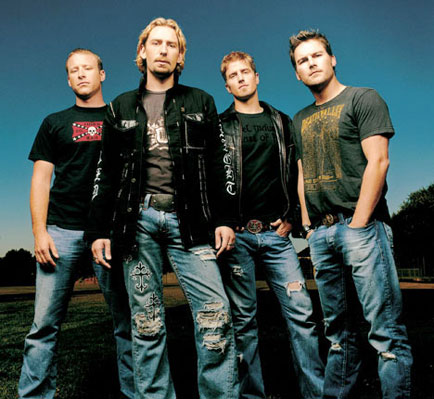COMMENT: Nickelback, the Talus Dome and some basic civility
Posted on November 27, 2011 By LH Thomson Culture, Front Slider, Visual Arts
 It’s funny how a small shift in perspective can change how we view things and influence human behaviour, particularly in the arts, where the debate between art, popularity and finance rages eternal.
It’s funny how a small shift in perspective can change how we view things and influence human behaviour, particularly in the arts, where the debate between art, popularity and finance rages eternal.
We all benefit from considering others’ perspectives sometimes, whether it’s on Nickelback being publically shunned or a public art installation.
One man’s interpretation of the Talus Dome, depicting a pyramid of reflective balls in Edmonton’s river valley, might be nuanced; it might be thoughtful, seeing it as “respectful of our shared humanity, our strengths, weaknesses, how the ebb and flow of life in this city is reflected in our river valley, our strongest structures and our steepest challenges.”
Another might look at it and say, “it’s a pyramid made out of silver Christmas tree ornaments that cost way too much, making suckers out of the taxpayers, spending public money that could be used to reduce the city’s growing debt and, for a select few, being the last thing that distracts them before they crash on the iciest stretch of the Quesnell Bridge.”
And they might both be right.
Similarly, someone might hear that Nickelback is playing at a big football game – say, in Detroit or at the Grey Cup in Vancouver – and note “who should play but a band that has sold nearly 50 million albums, defined a decade’s rock sound and headlined around globe,” further cementing the Hanna, Alberta band members as “rock legends.”
Another person might say Nickelback is a “repetitive, boring, boorish, immature, artistically bankrupt example of how the music business allows 16-year-olds to decide the brand, which it will then cynically fund to the tune of millions in promotion, guaranteeing they’ll be everywhere and popular, whether thinking people like them or not.”
And they might both be right.
You see, art is a matter of perspective. Pop culture is not.
Pop is just short for “popularity,” which is definable by all sorts of measurement. But the concept of “art” doesn’t come with a scale, or a qualification. It’s in the eye of the beholder.
An art student might be able to say how old a work is, the style and how that style appears to be competent or complex based on other works. But those don’t add up to a definite measurement. It’s still just the individual’s opinion.
So they’re two very different things.
Popularity doesn’t measure quality, or nuance, or complexity. And when we look at recent science and an understanding of how repetitive, simple auditory stimuli can produce feelings of happiness and comfort, it becomes easy to understand how a band’s familiar sound can make them “popular” without any conscious consideration of the complex values people try to judge in “art.”
That popularity is then enhanced by additional positive brain chemistry stirred up by the sense of community fans get from interacting together. The more hard-core the fan, the more the sense of community also keeps them involved, like orthodox religion. That’s true whether they’re Nickelback fans, Moonies, or members of a small, cliquey community in a typical city.
Meanwhile, the person who eschews popularity and looks for an “art” perspective is trying to take their individual view of the piece and, rather than use it for group comfort and affirmation, use it for self-expression. They see intellectual challenge and, therefore, the prospect of progressivism absent the need for community endorsement, in the artistic expressions of themselves and others .
They will still work together and forge relationships based on art, but its broader requirements for qualification means they’ll be …. members of a small, cliquey community in a typical city.
Sometimes, an artist borrows heavily from both camps, is popular and has staying power because of artistic reinvention. Other times, he sticks with what’s profitable for so long that he becomes a self-parody, where even fans start thinking it’s all a bit much.
Where is this all leading on Nickelback and public arts funding? Well when we use what we know about group behaviour and creative self-interest, we can reach a few sensible conclusions.
1) Nickelback is really popular. That doesn’t equate to any kind of artistic consensus on quality, it just means the band appeals to a lot of people.
If you measure art by complexity, originality, intelligence, introspection, and expression, it is a once-original band that has long since become a repetitive money machine thanks to a relentless touring and promotional schedule, a mass-market product that started with dubious value and has since plummeted into the realm of embarrassment, sort of like grocery store snack cakes.
But you know what? If repetitive crap brings fans together and that makes those fans happy, the band serves an entertainment purpose and more power to it. Who gives a shit if it’s not art? If you don’t like it, don’t listen. We all like snack cakes sometimes. Don’t like Nickelback? Fuck you, lifestyle Nazi. Mind your own business.
2) Public art is really unpopular right now because we’re in times of extreme need for fiscal restraint, based on high levels of debt on the part of the city, increasing local cost of living and growing tax burden. There’s also an increased mistrust in government to spend money carefully.
That doesn’t equate to a judgment on the value of these pieces as art, necessarily – as above, popular doesn’t necessarily equate to artistic.
It does mean that they don’t see it as money well-spent and on location alone, it probably isn’t.
Just as with Nickelback fans, the arts community is a tribe, and it protects and funds its own while also venerating those popular within its social subgenre. As a consequence, a city board can justify giving hundreds of thousands of dollars to famous design houses in London and California – rather than to artists in Alberta — just so they can tell their cliquey friends that, “we got the Balmond piece.” Pathetic. But those pieces were funded with a flat-rate 1% commitment to arts projects as part of each city capital project. So the fact that putting a status symbol on the Quesnell is dangerously stupid, or the fact that an engineering building is too out of the way to be worth the money is ignored.
In another media guise, I’ve had a chance to sit on a couple of federal arts funding panels, and the level of fraternization between those being funded and those handing out the money is astonishing, largely because most artists don’t even know the funds are available; the arts funding community is remarkably small. If public funding is truly going to be most effectively applied and with as few cases of self-interest involved as possible, we should either leave it directly to elected representatives, who can lose that position in the next vote, or the people handing out grants should excuse themselves whenever sheer artist familiarity is a factor in the decision, as that’s a measure of group/tribal fraternity, not a measure of community benefit.
 The location of the Talus Dome (which has since been repurposed as the framework for a swimming pool installation by its creators) is idiotic, and deserves criticism, and shame on anyone involved in the decision for having the pretension to think they know better than so many city drivers and taxpayers. Equally, the location of the new Cecil Balmond piece – in a northeast Edmonton industrial park – is ridiculous. The concept of beautifying “every” part of the city is nice, but not a practical consideration of other people’s money, and therefore UNCIVIL. It’s hard to justify beautifying a city engineering building in a town with about 2,000 people seeking affordable housing, a growing infrastructure deficit, the worst urban sprawl in North America and one of the most underdeveloped transit systems relative to area coverage.
The location of the Talus Dome (which has since been repurposed as the framework for a swimming pool installation by its creators) is idiotic, and deserves criticism, and shame on anyone involved in the decision for having the pretension to think they know better than so many city drivers and taxpayers. Equally, the location of the new Cecil Balmond piece – in a northeast Edmonton industrial park – is ridiculous. The concept of beautifying “every” part of the city is nice, but not a practical consideration of other people’s money, and therefore UNCIVIL. It’s hard to justify beautifying a city engineering building in a town with about 2,000 people seeking affordable housing, a growing infrastructure deficit, the worst urban sprawl in North America and one of the most underdeveloped transit systems relative to area coverage.
It is fine to promote public art. But it is not civil to override, ignore or not even consider the broader public consensus anytime discretionary spending is involved, particularly right now.
For every art major who thinks he has a right to give a friend or colleague a big chunk of public money – or even a small chunk for that matter – I cry “hypocrite” when they turn around and complain about public funds going to a business or bureaucracy. Art and its relationships to commerce and community priority are far too subjective for people to cry “expert” because they are artists themselves.
EVERY community, whether it surrounds a pop band like Nickelback or a small arts subculture like Edmonton’s, occasionally has its members favour one another. That group affirmation through mutual self-interest is why people value such affiliations in the first place, and why they stick with them like orthodox religions, even when the larger community disagrees: it gives them a sense of security to fulfil and share personal objectives.
But public money isn’t about personal objectives. It’s about the best use for the broadest base of users; it’s about efficiency. Because until we invent a fiat system that will allow instant input into any public spending decision, the best the public can rely on is the civility of the financial gatekeepers.
If you like Nickelback, more power to you. But don’t expect people to not criticize them as mass-produced pap and be annoyed when they’re over-programmed on FM radio, because that’s fundamentally logical. Popular doesn’t mean good.
If you like Edmonton’s public art, more power to you. But if in doing so, your perspective overrides the public’s priorities (and potentially the artistic sensibilities of the people whose money you’re doling out,) don’t expect them not to criticize you for being a pretentious twat, because that’s also fundamentally logical. Good doesn’t mean popular.
Or smart.











